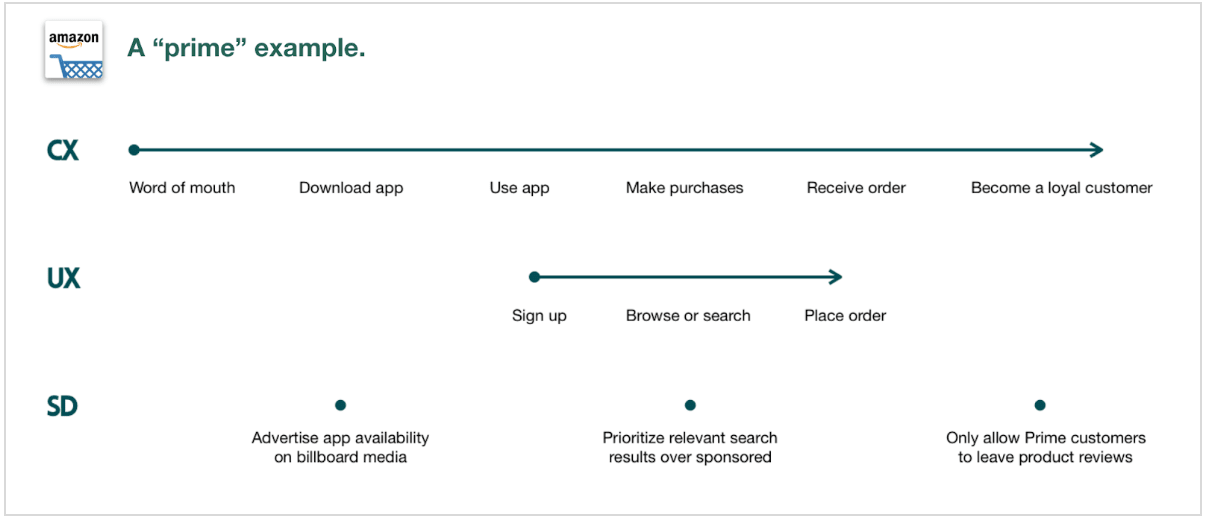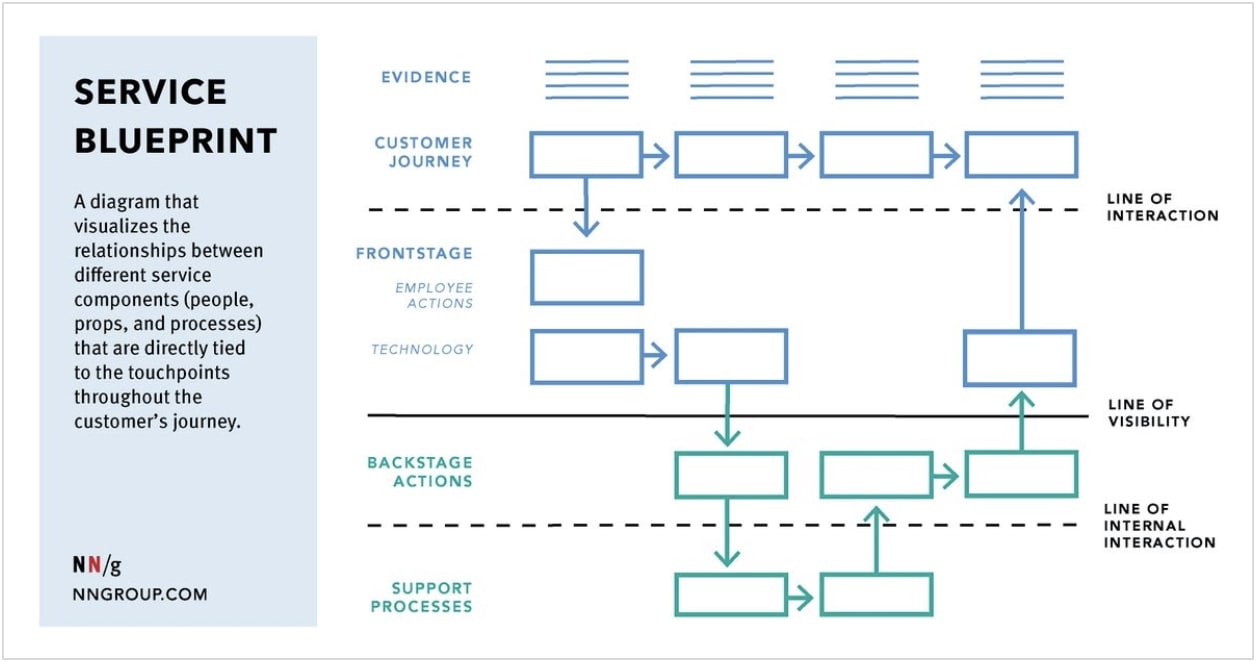What it means to be customer-centric
In a nutshell, a customer-centric approach to design is about realizing that what you're creating is not about what you think it should be. It’s about what somebody else, the customer, needs. It’s also a way to ensure that you’re anticipating customer needs based on an understanding of the user’s journey—meet them where they are.
The rise of Service Design
We are moving towards a Service Design model, where our research efforts consider the holistic experience—not just a product or a singular solution. This helps to ensure that every facet of an experience is optimized to best serve the customer.
While Service Designers seek a dedicated area of practice among other disciplines, there are key concepts from Service Design that help inform Customer and User Experience.
Let’s break it down:
Customer Experience (CX):The end-to-end journey, including both offline and online activities.
User Experience (UX):The quality of interactions through (typically digital) touchpoints within the journey.
Service Design (SD):The identification of opportunities that will improve both CX and UX.

Service Design
Service Design also allows us to understand what’s happening behind-the-scenes—it’s not limited to what customers see and touch. We can learn more about the infrastructure of a business (or business segment) as well as the people and processes that fuel it.
Ultimately, we aim to end up with an understanding of the business as complete as our clients/partners have. As a result, we get a multi-layered journey map that identifies people, processes, actions, time, and results—this is called the Service Blueprint. This is crucial in order to deeply understanding where systemic problems and opportunities lie within service delivery.

Service Blueprint
Ownership of Customer Experience and Service Design
While new roles and titles are constantly being introduced into the digital arena, the work ultimately remains the same. Typically, there is no single owner of these practices or their respective deliverables—and that’s perfectly okay. Journey Maps and Service Blueprints are highly collaborative documents that require deep research and perspectives from a variety of key players representing different disciplines. The usual suspects include (but are not limited to): Strategists, UX Designers, and Product Managers. A good chunk of this work happens in collaboration with our clients, as they often accumulate valuable historical data and have direct access to target customer segments.
A precursor to Journey Mapping or Service Blueprinting is a thorough Discovery process; we want to ensure that we are working with (or have access to) the latest, most accurate, and scalable insights from our clients.
The Creative Discovery process
A refined Discovery process should ladder up to outcomes that go beyond a laundry list of kickoff to-dos. Specifically, our Creative Discovery process is comprised of 5 major pillars that each prescribe specific activities and outputs:
- What the business needs
- Who the customers/users are
- What the customers/users need
- The state of the brand
- What others are doing in the space
If we can satisfy these 5 pillars during a Discovery phase, we are well on track to map out a truly customer-centric experience.
Customer Centric Design in Action: What we did for Staples Canada
As part of Discovery for our work with Staples, we conducted a round of thorough Field Research where we talked not only to customers but also in-store associates and staff at Staples’ print hub facilities. This gave us a 360-degree view of everything and everyone involved in a typical print-and-copy transaction—a snapshot of the holistic experience. Only talking to customers is limiting and sometimes incongruent with where the business wants to go. Understanding the needs and wants of all key players involved truly allows us to deliver the most relevant and robust customer experience. Part of our intention was also to make life easier for in-store associates and print hub staff. If their day-to-day work lives are improved, they can and will feel empowered to deliver better service to customers. Everyone wins.
While our initial engagement was to enhance Staples' online print project builder, we also delivered a Service Blueprint that contextualized the project within a much bigger picture. We won the trust of our client by mapping out (and thus, honoring) the complexities of their business segment, giving our work the best foundation for long-term success.
Looking ahead
Innovation plays a huge role in the delivery of great service. This goes beyond specific touchpoints and interactions—it’s about the business at large. The business that you are today will likely change five years from now and, as a result, you might go after a different customer base. As such, it’s important to have your finger on the pulse of the competitive landscape, especially in a digital economy that evolves at lightspeed.
Because customer-centricity as a mindset has gained serious traction over the last decade, it’s only fair to assume that brands will rise to better define the experience they provide via their service touchpoints. Just as a lot of brands have a strong grasp of their brand guidelines (including usage of their logo and their colors), it’s very possible that they will begin to define and champion their Experience Strategy. It may even be something that they have in their back pocket, ready to discuss with potential partners versus needing an Experience Strategy crafted for them.

